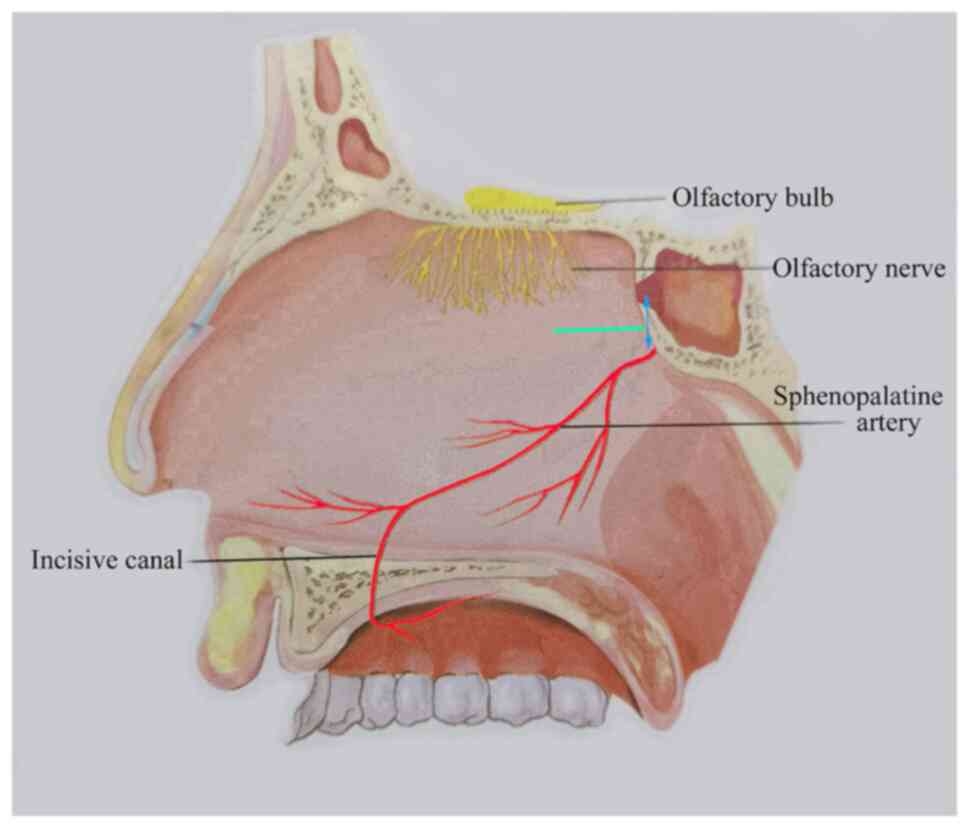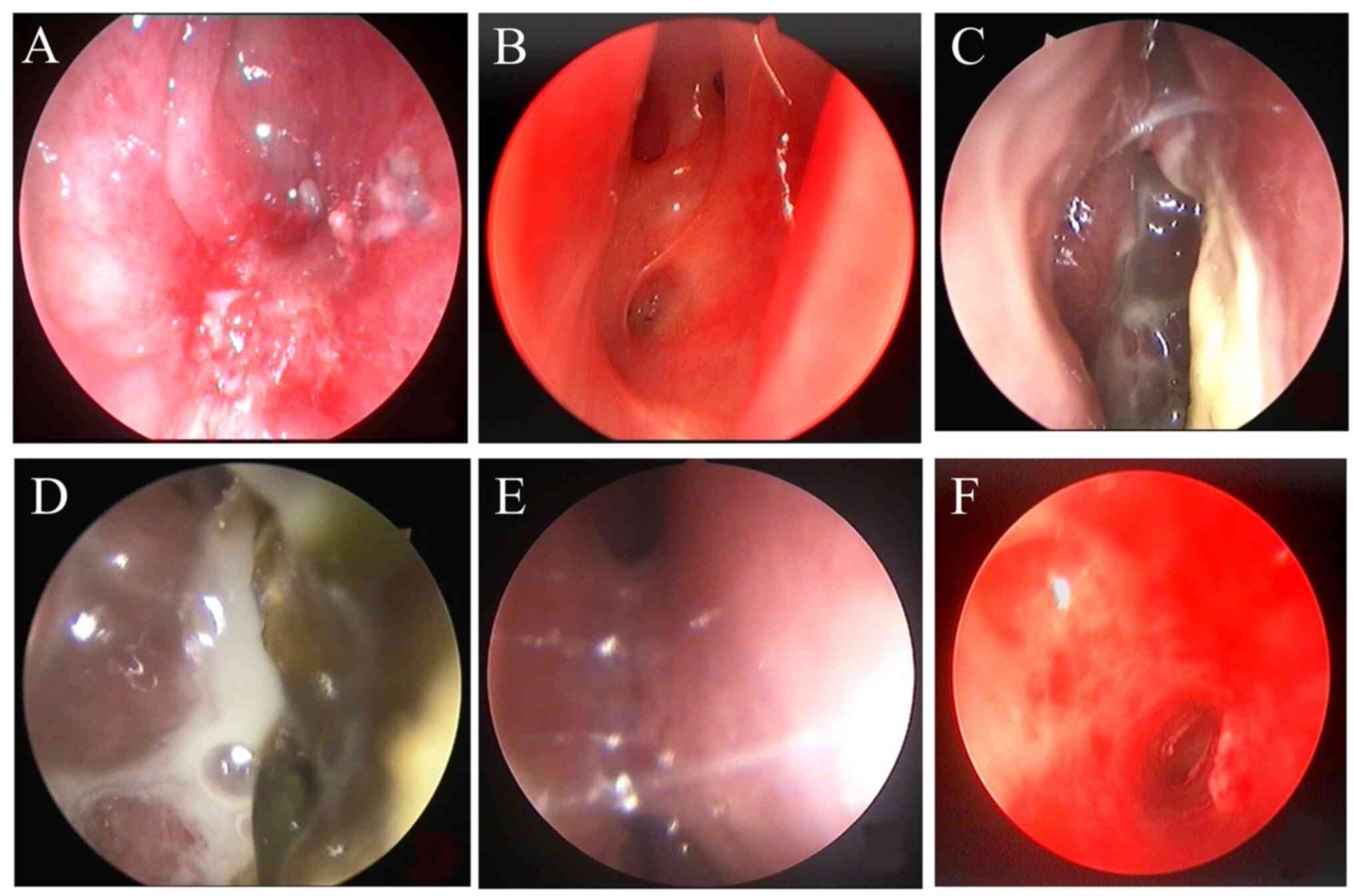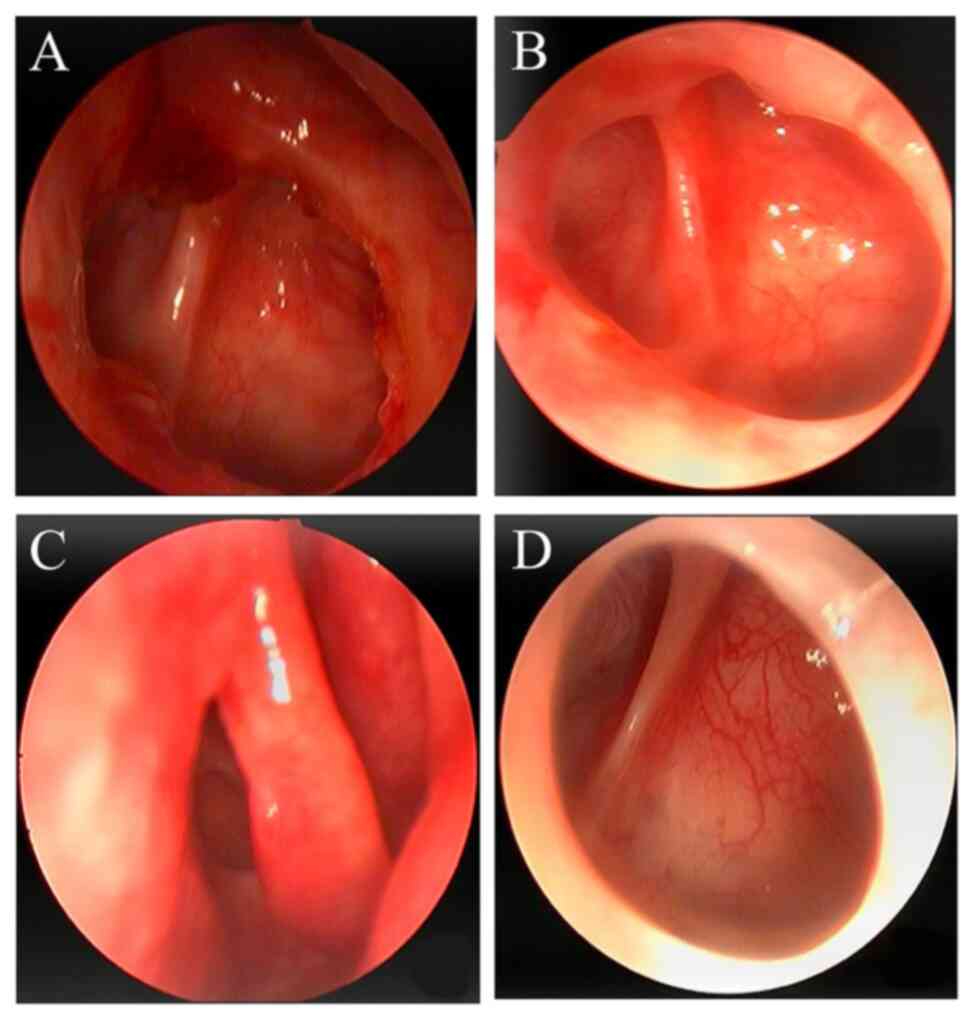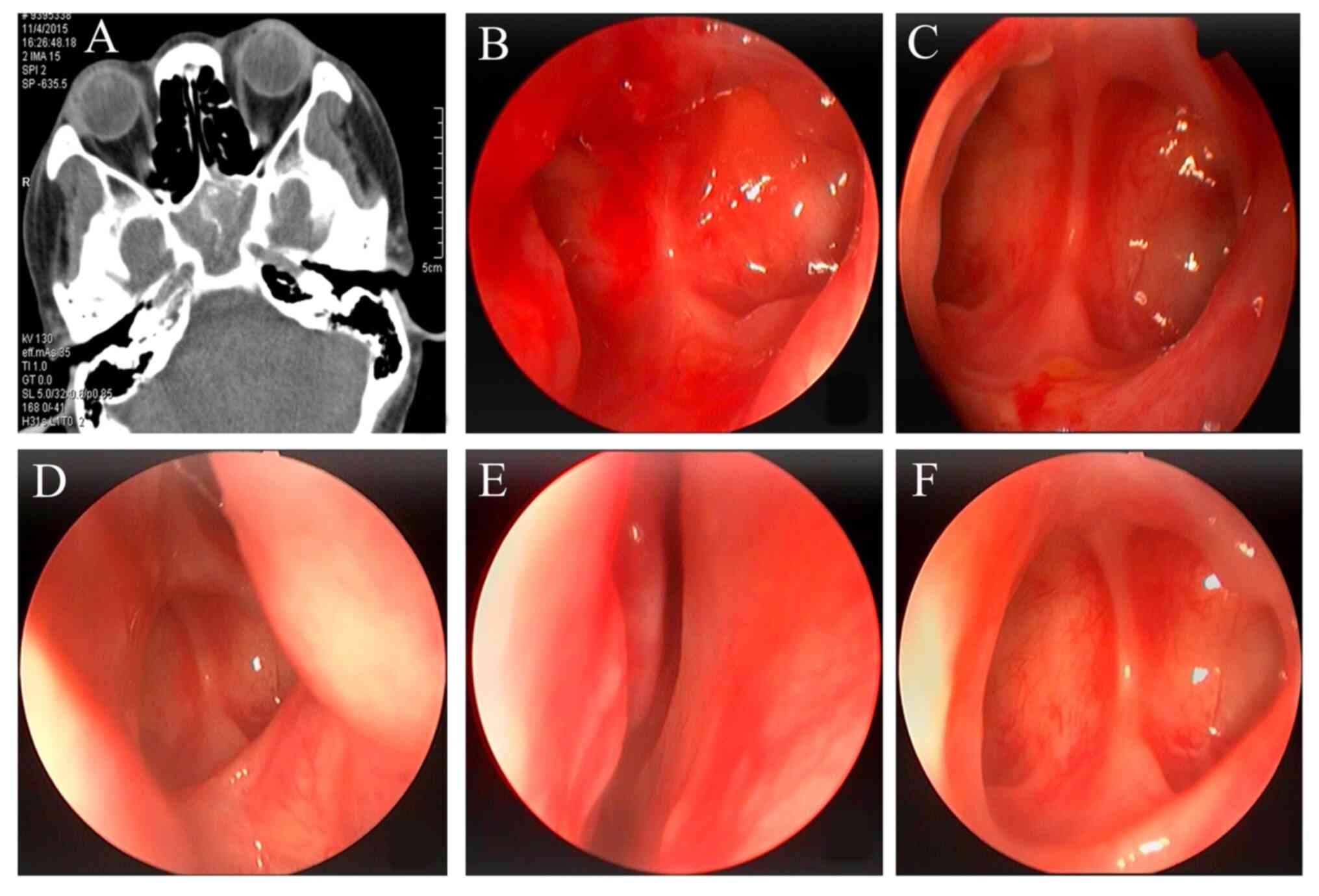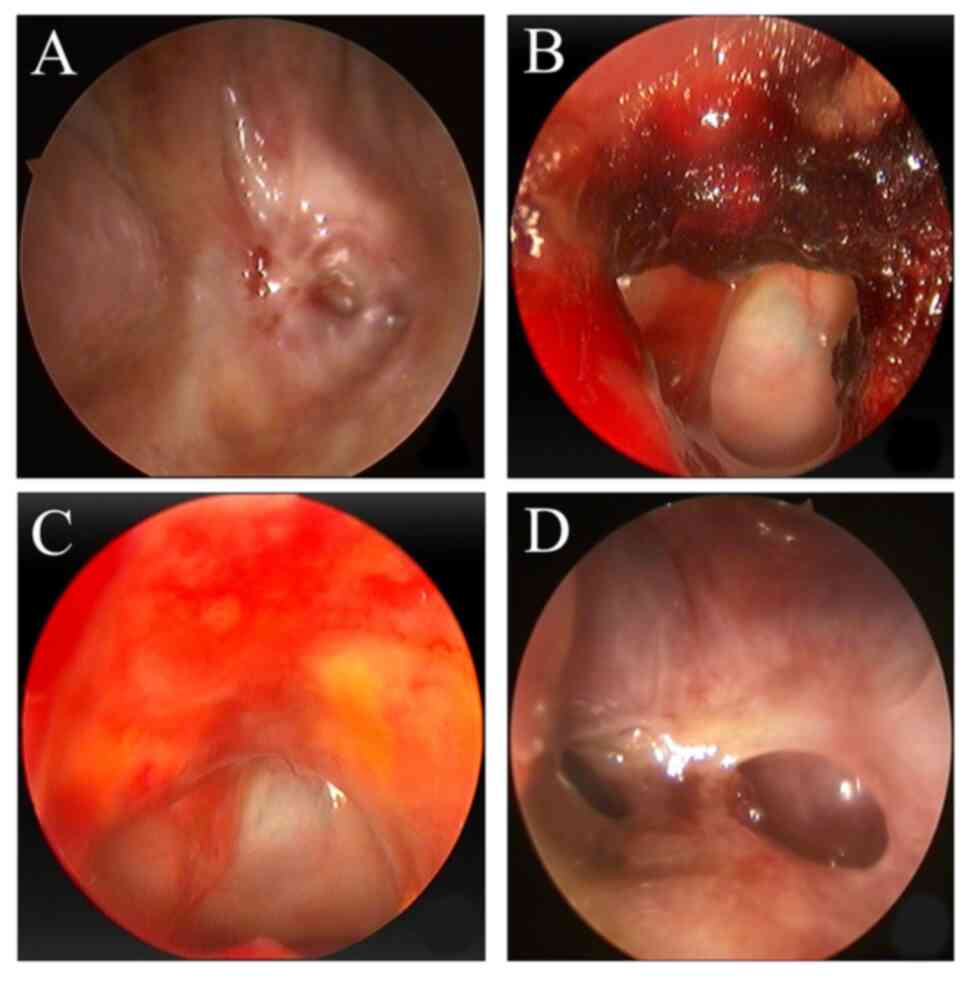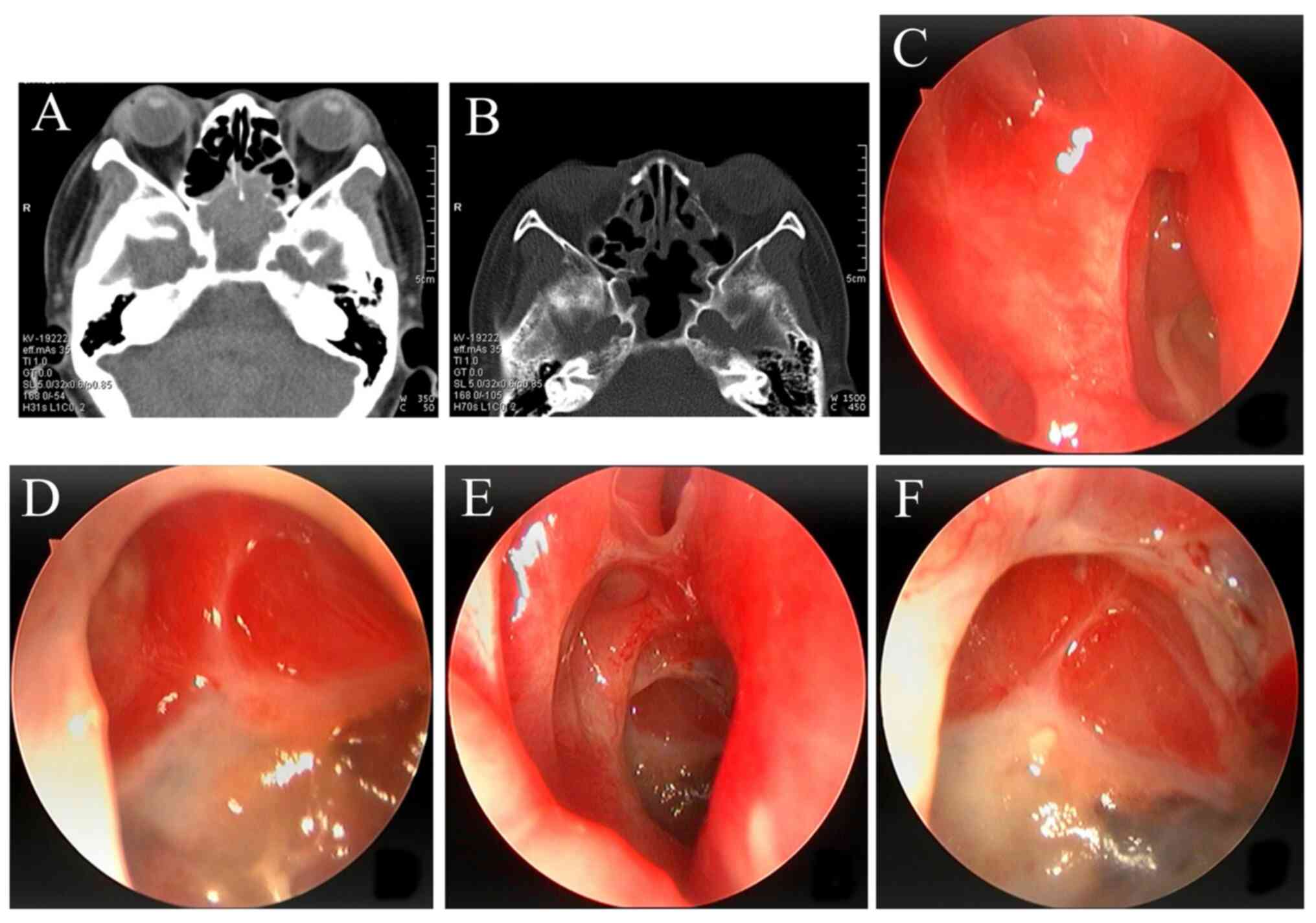Application of expanding bilateral sphenoid sinus plasty in the treatment of sphenoid sinus diseases
- Authors:
- Published online on: July 7, 2023 https://doi.org/10.3892/etm.2023.12101
- Article Number: 401
-
Copyright: © Xue et al. This is an open access article distributed under the terms of Creative Commons Attribution License.
Abstract
Introduction
It is difficult to expose the sphenoid sinus considering its location deep inside the sphenoid bone and adjacent to the basis cranii. The sphenoid sinus is close to important anatomical structures, such as the optic nerve, internal carotid artery and sella turcica, which makes the management of sphenoid sinus lesions challenging (1). The blood vessels and olfactory nerve endings are widely distributed in the surgical field, thus bleeding during or post-surgery and postoperative olfactory hypofunction are prone to occur (2,3). Moreover, these characteristics may give rise to challenging surgical operations, incomplete cleaning of sphenoid sinus lesions, diverse surgical complications and rapid recurrence of lesions after operation (4,5).
Primary functional endoscopic sinus surgery is effective in treating medically refractory chronic rhinosinusitis, with ~5-15% of patients requiring revision, endoscopic sinus surgery (6), which indicates that a marked proportion of patients will require >1 revision sinus surgery. Surgery of the sphenoid sinus is always affected by nasal anatomy, surgical instruments, lesion characteristics and the experience of the operator, which means that the revision rate may be higher (5).
It was observed that, in clinical practice, the rate of orifice re-closing after sphenoid sinus surgery, especially refractory sphenoid sinusitis, was high (4). Refractory sphenoid sinusitis refers to patients in whom sphenoid sinusitis has not been effectively controlled >3 months post standard nasal endoscopic surgery and comprehensive treatment, with persistent chronic inflammation in the operative cavity as well as prolonged symptoms and signs for >6 months after follow-up (7). Most patients with refractory sphenoid sinusitis are characterized by sphenoid sinus stenosis, small sinus cavity volume, heavy mucosal inflammation in the sinus cavity, peripheral bone hyperplasia and easy recurrence after surgery (8). Sphenoid sinus scar stenosis or sphenoid sinus atresia after surgery, which are difficult to deal with in the clinic, commonly appear when routine sphenoid sinus surgery is performed using a nasal endoscope. Furthermore, local recurrence is also a problem for patients with sphenoidal tumor (1,4,5).
Currently, approaches to transnasal endoscopic sphenoid sinus surgery can be grouped as follows: The Messerklinger approach, the Wingand approach, Transphenoidal septum into the contralateral sphenoid sinus approach and trans-medial plate of pterygoid process approach (9-12). The principles common to the aforementioned approaches are to fully open the sphenoid sinus, completely remove the lesion and to maintain drainage. The more traditional and the most widely used surgical approaches in the sphenoid sinus are via the trans-superior meatus or the transethmoidal sinus and other contralateral or lateral approaches (both on the lateral side of nasal septum) (11,12). There are seldom reports of sphenoidal surgery through the nasal septum mucoperiosteal incision. In the present study, the new methodological application of expanding bilateral sphenoid sinus plasty was evaluated. The surgical outcomes of 42 cases of sphenoid sinus diseases treated using expanding bilateral sphenoid sinus plasty using the nasal endoscope and the postoperative curative effects in patients were observed.
Materials and methods
Clinical data
The present study was performed at The Medical School of Nanjing University Affiliated Jinling Hospital (Nanjing, China). Each patient signed an informed consent before surgery. The study was approved by the Ethics Committees of The Medical School of Nanjing University Affiliated Jinling Hospital (approval no. 2012NKY011). A total of 42 patients with sphenoid sinus lesions, confirmed during the first surgical operation and reoperation pathology, from December 2012 to December 2018 were included in the study. The group included 26 males and 16 females, with mean age of 45.7 years (range 22-75 years). The sphenoid sinus lesions included 15 patients with refractory sphenoid sinusitis (with 3 patients with postoperative complications of pituitary adenoma), 9 patients with sphenoidal mucoceles, 8 patients with fungal sphenoid sinusitis (with 1 patient having intracranial infection and fever), 3 patients with sphenoid sinus papilloma, 2 patients with posterior sphenoid nostril polyps, 2 patients with sphenoid sinus carcinoma, 1 patient with sphenoid sinus chordoma, 1 patient with pituitary adenoma and 1 patient with olfactory neuroblastoma with sphenoid sinus and intracranial invasion. The clinical symptoms were as follows: Headache (36 patients), purulent runny nose (23 patients), nosebleed or bloody runny nose (18 patients), nasal obstruction (16 patients), hyposmia (6 patients), diplopia (3 patients), vision decline (2 patients), exophthalmos or distended pain (2 patients), fever (1 patient) and vomiting (1 patient). The disease course ranged from 6 months to 11 years, with a median of 2.6 years. A total of 21 patients underwent a second surgical operation, including refractory sphenoid sinusitis (15 patients), sphenoidal mucoceles (2 patients), sphenoid sinus papilloma (2 patients), fungal sphenoid sinusitis (1 patient), and sphenoid sinus carcinoma (1 patient).
Preoperative examination
All patients underwent routine physical examinations prior to surgery. There were no apparent surgical contraindications. Nasal endoscopy and 64-slice computerized tomography (CT) scan of the sinuses were performed using the coronal, axial and sagittal positions. A total of 21 patients underwent MRI examination, including 3 patients with refractory sphenoid sinusitis and postoperative complications of pituitary adenoma, 9 patients with sphenoid mucoceles, 1 patients with fungal sphenoid sinusitis and having intracranial infection and fever, 3 patients with sphenoid sinus papilloma, 2 patients with sphenoid sinus carcinoma, 1 patient with sphenoid sinus chordoma, 1 patient with pituitary adenoma and 1 patient with olfactory neuroblastoma with sphenoid sinus and intracranial invasion. MRI was only performed for patients with sphenoid sinus tumors and when MRI was of great significance in the diagnosis, scope and surgical guidance of sphenoid sinus lesions. The development, location and expansion of the sphenoid sinus were respectively determined. The operative risk and the surgical plan for all patients were assessed.
Surgical procedure
All patients underwent expanding bilateral sphenoid sinus plasty under general anesthesia. Surgery was performed as follows: With a 30˚ nasal endoscope (Karl Storz SE & Co. KG), having conducted the external transfer of middle turbinate without resection, the superior meatus, the nasal septum and the recessus sphenoethmoidalis were fully exposed. After local electrocauterization with the bipolar coagulation, an incision ~2 cm long (indicated by a green line in Fig. 1) was formed on the root mucosa of the nasal septum 2 mm below the recessus sphenoethmoidalis or the natural opening of sphenoid sinus. The mucoperiosteum was separated and cotton pads were applied to protect the mucosal flaps. The nasal septum fracture was separated but the contralateral nasal mucosa was kept intact. The sphenoid ridge and exposed posterior nasal septum were fully removed using a drill and the sphenoidal intersinus septum was removed. The opening of sphenoid sinus was ground to its bottommost part and the bilateral sphenoid sinus was integrated into a single cavity. The intact nasal septum flaps were reset to the sphenoidal cavity and the middle turbinate was repositioned anatomically after complete removal of sphenoid sinus lesions.
Improvements of surgical operation: A unilateral incision or bilateral approach can be used. Tumors should be thoroughly resected. The contralateral side may not need a transverse incision. Insertion into the surgical operation cavity through the recessus sphenoethmoidalis is suitable, which can fully expose the lesions and is minimally invasive. When removing the lateral lesions of the sphenoid sinus, a 30˚ or 45˚ endoscope can be placed in the contralateral cavity to expose and operate in a safe and convenient way. To reduce the surgical trauma, a bilateral transverse incision can be avoided. We have adopted the above methods on patients with sphenoid sinus tumors.
Patient follow-up
Patients were followed up for 6-53 months, with a median follow-up time of 16.5 months. The first nasal cleaning was performed 1 week post-surgery. Local cleaning using a nasal endoscopic was performed at an interval of 1-2 weeks according to the local recovery of the surgical cavity until a complete regeneration of the mucosal epithelization in the sphenoid sinus and the opening.
Statistical analysis
SPSS 19.0 (IBM Corp.) was used for statistical analysis. Continuous variables were expressed as mean (range) or median (range) and compared using Student's t-test or the Wilcoxon rank-sum test. Categorical variables were expressed as frequency (percentage) and analyzed using the χ2 test or, where the expected count in >20% of cells was <5. Fisher's exact test was used to analyze categorical variables. P<0.05 was considered to indicate a statistically significant difference.
Results
A total of 15 patients with refractory sphenoid sinusitis were considered to be cured with a well opened sphenoid sinus orifice and clean cavity. The sphenoidal lesions were completely removed in 9 patients with sphenoidal mucoceles, 8 patients with fungal sphenoid sinusitis (including 1 patient whose treatment was complicated by intracranial infection and fever as well as receiving postoperative antifungal therapy for 3 months, with intracranial lesion absorption observed), 3 patients with sphenoidal papilloma, 2 patients with post-sphenoidal nostril polyp and 1 patient with hypophysoma. Two patients with sphenoidal carcinoma and one patient with sphenoidal chordoma were treated using endoscopic resection and postoperative radiotherapy. A patient with olfactory neuroblastoma with sphenoid sinus and intracranial invasion was treated with combined neurosurgery, lesion resection and postoperative radiotherapy.
In the 42 patients, symptoms were relieved after operation except preoperative hyposmia in 2 patients and impaired vision in 1 patient with no obvious improvement. There were no complications, such as arterial nosebleed, olfactory decline or perforation of the nasal septum. The postoperative mucosal epithelization of the operation cavity regenerated well. The total time for regeneration and epithelization was 6-14 weeks (mean, 8.6 weeks). Patients with sphenoid sinus carcinoma and sphenoid sinus chordoma underwent radiotherapy after surgical operation. Two patients with sphenoid sinus carcinoma were followed up for 10 and 14 months, with no recurrence. One patient with sphenoid chordoma was followed up for 10 months, without recurrence. One patient with olfactory neuroblastoma with sphenoid sinus and intracranial invasion was followed up for 8 months, without recurrence.
Endoscopic sinus reexamination demonstrated that the sphenoid sinus orifice was well opened and no sphenoid sinus orifice closure was observed in any of the 42 patients. The data before and after surgical operation and the follow-up results were presented in the figures. Fig. 2 showed the nasal endoscopic images of sphenoid sinus opening failure. The endoscopic follow-up of a patient with sphenoidal mucocele was shown in Fig. 3, follow-up of a patient with fungal sphenoid sinusitis with CT and nasal endoscopy was shown in Fig. 4 and the follow-up results of a patient with refractory sphenoid sinusitis were shown in Fig. 5. The benign lesions were treated with the one-sided approach. The bilateral exposure and surgery were applied for sphenoid sinus tumor lesions, and the follow-up results of a patient with sphenoid sinus carcinoma using CT and nasal endoscopy were shown in Fig. 6.
The characteristics of patients treated with expanding bilateral sphenoid sinus plasty and traditional sphenoid sinus plasty were compared (Table I). The data demonstrated that procedure length was significantly longer and hospital stay was significantly shorter observed in patients treated using expanding bilateral sphenoid sinus plasty compared with those treated using traditional sphenoid sinus plasty. There was no significant difference in intraoperative bleeding volume. With regards complications, the occurrence rate of arterial nosebleed (0 vs. 5), nasal cavity adhesion (2 vs. 8), olfactory decline (0 vs. 5) and perforation of nasal septum (0 vs. 2) were markedly reduced in patients with expanding bilateral sphenoid sinus plasty compared with the traditional group; however, no statistical significance was demonstrated. Moreover, no sphenoid sinus orifice closures were observed postoperatively, no revision operations were performed and the epithelialization time was significantly shorter in patients treated using expanding bilateral sphenoid sinus plasty compared with the traditional group.
Discussion
The anatomical position of the sphenoid sinus is considered special in view of its proximity to vital anatomical structures, such as the internal carotid artery, sella turcica, pituitary, optic nerve, sinus cavernosus, visual cross and the third to the sixth cranial nerve (13-15). This poses a challenge for the clinical diagnosis and treatment of sphenoidal disease. In the present study, a conventional nasal endoscopic examination was carried out and the imaging pictures were carefully analyzed. The scope of the lesion in relation to surrounding tissues was assessed. Blind operation was avoided during surgical procedures and the sphenoid sinus lesion was removed as thoroughly as possible.
Recurrence of refractory sphenoid sinusitis is the most common side effect encountered in sphenoidal disease after surgical operation (4). Patients commonly have characteristics such as stenosis of the sphenoid sinus orifice, small volume of chamber, severe inflammation of the sinus mucosa and easy recurrence after surgery (16). It is essential to fully open the apertura sinus sphenoidalis and protect the mucosa of the surgical cavity during surgical operation, to avoid postoperative scar stenosis of the sinus orifice (8). In the present study, expanding bilateral sphenoid sinus plasty was used to open the sphenoid sinus orifice while protecting the mucosa of the surgical cavity. The apertura sinus sphenoidalis was higher than the bottom wall of the sinus; therefore, the posterior of the nasal septum and the anterior inferior wall of sphenoid sinus were removed during surgery and the opening of the sphenoid sinus was drilled to its bottommost part, which enabled the bilateral sphenoid sinus to be completely opened to facilitate drainage. Furthermore, in the long-term post-nasal endoscopic treatment, it was observed that the sphenoid sinus opening frequently appeared in various degrees of annular reduction post-surgery. Based on the present study, it is suggested that the fenestration should not be too small. Meanwhile, after the bilateral sphenoid sinus was fully opened, the well-preserved nasal septum mucosal flaps could be reset to the sphenoidal cavity, which promoted the rapid epithelization of the mucous membrane in the sphenoid cavity, avoided local scar formation and reduced postoperative recurrence or fenestration atresia.
Safety during surgical operation must be considered during the treatment of sphenoid sinus lesions (17). Hence, to avoid serious surgical complications, the surgeon must not blindly clamp and drag the lesion of the lateral wall or scratch the mucous membrane of the lateral wall (18,19). In the present study, angle nasal endoscopy was combined with expanding bilateral sphenoid sinus plasty to address sphenoid sinus lesions. The surgical field was fully exposed and clearly visible, which allowed operators to avoid accidental injuries of important anatomical structures. Most surgical operations were performed in the midline or medial, which features high security, and thus, damage to the lateral internal carotid artery and optic nerve of sphenoid sinus could be avoided (20). A transverse incision of the mucoperiosteum at the root of the nasal septum was adopted to preserve the sphenopalatine artery pedicle and its nasal septum branches and to maintain the integrity of olfactory epithelium, especially the mucosa of the septal olfactory strip (21,22). This also reduced the risk of postoperative nosebleed, perforation of the nasal septum and olfactory disturbance. So, the expanding bilateral sphenoid sinus plasty is mainly characterized by avoiding the medial olfactory band, sphenopalatine artery and lateral internal carotid artery, and optic nerve, and improving the safety of the operation while reducing postoperative complications.
The most important aspect of this surgical method is to achieve full exposure of the operative field and create a better condition for the full-treatment of the sphenoid sinus lesion, which can reduce the recurrence probability of the lesion. For better gasification of the sphenoid sinus, some of the air chambers can be extended to the root of the pterygoid process to form the lateral recess of the sphenoid sinus (23). Usually, to enable a clear exposure and ensure safer and more convenient surgical operation, a 30˚ or 45˚ endoscope is used to clear the lateral lesions of the sphenoid sinus (24). The present study made a preliminary evaluation of how to improve the surgical procedure, which is mainly embodied in a one-sided or double-sided approach. The bilateral approach is mainly applicable for sphenoid sinus tumors. It follows the principle of completely resecting the tumor and minimizing surgical trauma. The operation space increases with the full exposure of the sphenoid sinus cavity. The operating assistant can help aspirate the blood and expose the surgical field from another side, which enables the surgeon to operate with both hands simultaneously. Surgeons need to master local anatomy and surgical approach, as well as specialize in analyzing sphenoid sinus lesions and the imaging of morphological changes (25-27).
In the present study, the normal and healthy mucous membranes of the nasal cavity, the sphenoid sinus, and the nasal septum were retained as much as possible (28). The mucosal flap technique was applied to protect the mucosa of the nasal septum; the nasal septum mucosal flaps were reset to the sphenoidal cavity; the nasal mucosa of the opposite side was kept intact; the minimum amount of the mucosa of the sphenoid sinus was removed and the turbinate was kept; and the excessive electrocauterization of the bleeding mucosa, particularly the mucosal margins, was avoided. The incision and separation of the nasal septum mucoperiosteum should be kept neat so as to not damage the vascular pedicle and nasal septum olfactory band. This method can form sufficiently large mucosal flaps to retain the anatomical structure of the nasal cavity and sphenoid sinus, and boost the healing of the mucous membrane after surgery. The contralateral nasal mucosa is not easily damaged once the osseous nasal septum is broken. Keeping the contralateral nasal mucosa intact can avoid the disturbance of its nasal cavity and sinus function. Furthermore, subperiosteal peeling anatomy is beneficial for the protection of the nasal mucosa and it can improve the long-term healing ability of nasal cavity, which can reduce the forming of scab and shorten the process of epithelial transformation of the nasal cavity and sinuses. It is necessary to examine and clear the postoperative cavity under the endoscope periodically for quick recovery post-surgical operation (29). Regular endoscopic follow-up was performed after the operation. If the operational areas under the nasal endoscope are smooth, there is no obvious hyperemia and edema in the mucosa, no obvious residual lesion and the ostium of the sinus is well opened, then it is considered that epithelialization was successful. In the present study, the mean time of mucosa epithelial transformation for patients was ~8.6 weeks post-surgery, which was significantly shorter compared with traditional sphenoid sinus plasty-treated patients.
For certain simple cases with better gasification of the sphenoid sinus and no obvious anatomical variation, the trauma using this surgical method may be larger. The incision and the particular method used here may produce excessive damage. However, expanding bilateral sphenoid sinus plasty is necessary for patients with refractory sphenoid sinusitis, especially for malignant tumors of the sphenoid sinus (30). The present study is a case series, thus certain limitations and shortcomings exist. A larger study population recruited in a prospective or randomized fashion with validated outcome measures would allow for a more conclusive analysis of the benefits of expanding bilateral sphenoid sinus plasty for sphenoid sinus diseases.
In summary, the advantages of the expanding bilateral sphenoid sinus plasty, as indicated by the present study, are as follows: i) It enables a fully exposed and clear surgical field, which leads to the complete removal of lesions in the sphenoid sinus; ii) it can fully open the apertura sinus sphenoidalis and protect the mucous membrane of the operation cavity to reduce recurrence; iii) it can promote rapid epithelization of the mucosa of the sphenoid sinus cavity and the opening postoperatively; iv) higher safety and no injury of internal carotid artery and optic nerve; v) postoperative complications are minimal, thus the risk of postoperative nosebleed, perforation of nasal septum and olfactory disorder is reduced; and vi) the follow-up treatment is intuitionistic and convenient. In the present study, no sphenoid sinus orifice closure was identified in patients during follow-up. The results of the present study indicated that this procedure is suitable for use in most cases of sphenoid sinus lesions. The same surgical incision and sphenoid sinus exposure also provides sufficient surgical exposure for transsphenoid pituitary adenoma surgery and transsphenoid treatment of suprasaddle and parasellar lesions. Currently, preliminary adoption of this method has been achieved in the Neurosurgery Department of our hospital (5).
Acknowledgements
Not applicable.
Funding
Funding: The present study was supported by the China Postdoctoral Science Foundation (grant no. 2017M613438) and by the Medical School of Nanjing University Affiliated Jinling Hospital (grant no. 2017001).
Availability of data and materials
The datasets used and/or analyzed during the current study are available from the corresponding author on reasonable request.
Authors' contributions
FX, YC and RW contributed to the study design and performed the funding acquisition. FX, XY and YC contributed to data collection and wrote the manuscript. MW and JJ performed data validation and retouched the manuscript. XF, YC and MW confirm the authenticity of all the raw data. All authors have read and approved the final manuscript.
Ethics approval and consent to participate
This study was approved by the Ethics Committees of the Medical School of Nanjing University Affiliated Jinling Hospital (approval no. 2012NKY011). Written informed consent was obtained from all patients.
Patient consent for publication
Not applicable.
Competing interests
The authors declare that they have no competing interests.
References
|
Chen L, Jiang L, Yang B and Subramanian PS: Clinical features of visual disturbances secondary to isolated sphenoid sinus inflammatory diseases. BMC Ophthalmol. 17(237)2017.PubMed/NCBI View Article : Google Scholar | |
|
De Los Reyes KM, Gross BA, Frerichs KU, Dunn IF, Lin N, Rincon-Torroella J, Annino DJ and Laws ER: Incidence, risk factors and management of severe post-transsphenoidal epistaxis. J Clin Neurosci. 22:116–122. 2015.PubMed/NCBI View Article : Google Scholar | |
|
ZA Lang, HB Sheng and AW B: Long-term olfactory dysfunction after single-nostril endoscopic transnasal transsphenoidal pituitary adenoma surgery. J Clin Neurosci. 82:166–172. 2020.PubMed/NCBI View Article : Google Scholar | |
|
Van Zele T, Pauwels B, Dewaele F, Gevaert P and Bachert C: Prospective study on the outcome of the sphenoid drill out procedure. Rhinology. 56:178–182. 2018.PubMed/NCBI View Article : Google Scholar | |
|
Cheng Y, Xue F, Wang TY, Ji JF, Chen W, Wang ZY, Xu L, Hang CH and Liu XF: Analyses and treatments of postoperative nasal complications after endonasal transsphenoidal resection of pituitary neoplasms. Medicine (Baltimore). 96(e6614)2017.PubMed/NCBI View Article : Google Scholar | |
|
Leight WD and Leopold DA: Sphenoid ‘drill-out’ for chronic sphenoid rhinosinusitis. Int Forum Allergy Rhinol. 1:64–69. 2011.PubMed/NCBI View Article : Google Scholar | |
|
Subspecialty Group of Rhinology, Editorial Board of Chinese Journal of Otorhinolaryngology Head and Neck Surgery; Subspecialty Group of Rhinology, Society of Otorhinolaryngology Head and Neck Surgery, Chinese Medical Association. Guidelines for diagnosis and treatment of chronic rhinosinusitis (2012, Kunming). Zhonghua Er Bi Yan Hou Tou Jing Wai Ke Za Zhi. 48:92–94. 2013.PubMed/NCBI(In Chinese). | |
|
Eloy JA, Marchiano E and Vázquez A: Extended endoscopic and open sinus surgery for refractory chronic rhinosinusitis. Otolaryngol Clin North Am. 50:165–182. 2017.PubMed/NCBI View Article : Google Scholar | |
|
Stammberger H and Posawetz W: Functional endoscopic sinus surgery. Concept, indications and results of the Messerklinger technique. Eur Arch Otorhinolaryngol. 247:63–76. 1990.PubMed/NCBI View Article : Google Scholar | |
|
Toffel PH, Aroesty DJ and Weinmann RH IX: Secure endoscopic sinus surgery as an adjunct to functional nasal surgery. Arch Otolaryngol Head Neck Surg. 115:822–825. 1989.PubMed/NCBI View Article : Google Scholar | |
|
Lubbe DE, Douglas-Jones P, Wasl H, Mustak H and Semple PL: Contralateral precaruncular approach to the lateral sphenoid Sinus-A case report detailing a new, multiportal approach to lesions, and defects in the lateral aspect of well-pneumatized sphenoid sinuses. Ear Nose Throat J. 99:62–67. 2020.PubMed/NCBI View Article : Google Scholar | |
|
Huang Q, Zhou B, Cui SJ and Li YC: The application of endoscopic strategy and approaches to treat sphenoid sinus inflammatory diseases. Lin Chuang Er Bi Yan Hou Tou Jing Wai Ke Za Zhi. 30:1265–1270. 2016.PubMed/NCBI View Article : Google Scholar : (In Chinese). | |
|
Burke MC, Taheri R, Bhojwani R and Singh A: A practical approach to the imaging interpretation of sphenoid sinus pathology. Curr Probl Diagn Radiol. 44:360–370. 2015.PubMed/NCBI View Article : Google Scholar | |
|
Turkdogan FT, Turkdogan KA, Dogan M and Atalar MH: Assessment of sphenoid sinus related anatomic variations with computed tomography. Pan Afr Med J. 27(109)2017.PubMed/NCBI View Article : Google Scholar | |
|
Liu J, Liu S, Heng X, Fei C, Wei Y, Zhang J, Zhang Z and Tang Y: The values of thin sections and three-dimensional reconstruction in the sellar region. World Neurosurg. 78:510–515. 2012.PubMed/NCBI View Article : Google Scholar | |
|
Cingi C, Bayar Muluk N and Lee JT: Current indications for balloon sinuplasty. Curr Opin Otolaryngol Head Neck Surg. 27:7–13. 2019.PubMed/NCBI View Article : Google Scholar | |
|
Samandouras G, Kerr RS and Milford CA: Minimally invasive biopsy of parasellar lesions: Safety and clinical applications of the endoscopic, transnasal approach. Br J Neurosurg. 19:338–344. 2005.PubMed/NCBI View Article : Google Scholar | |
|
Dehdashti AR, Ganna A, Karabatsou K and Gentili F: Pure endoscopic endonasal approach for pituitary adenomas: Early surgical results in 200 patients and comparison with previous microsurgical series. Neurosurgery. 62:1006–1017. 2008.PubMed/NCBI View Article : Google Scholar | |
|
Laury AM, Oyesiku NM, Hadjipanayis CG, Delgaudio JM and Wise SK: Incidental sinonasal findings identified during preoperative evaluation for endoscopic transsphenoidal approaches. Am J Rhinol Allergy. 27:202–205. 2013.PubMed/NCBI View Article : Google Scholar | |
|
Wormald PJ and McDonogh M: ‘Bath-plug’ technique for the endoscopic management of cerebrospinal fluid leaks. J Laryngol Otol. 111:1042–1046. 1997.PubMed/NCBI View Article : Google Scholar | |
|
Ng YH and Sethi DS: Isolated sphenoid sinus disease: Differential diagnosis and management. Curr Opin Otolaryngol Head Neck Surg. 19:16–20. 2011.PubMed/NCBI View Article : Google Scholar | |
|
Eravcı FC, Ceylan A, Göcek M, İlerı F, Uslu SS, Yılmaz M and Kızıl Y: Isolated sphenoid sinus pathologies: A series of 40 cases. Turk J Med Sci. 47:1560–1567. 2017.PubMed/NCBI View Article : Google Scholar | |
|
Özer CM, Atalar K, Öz II, Toprak S and Barut Ç: Sphenoid sinus in relation to age, gender, and cephalometric indices. J Craniofac Surg. 29:2319–2326. 2018.PubMed/NCBI View Article : Google Scholar | |
|
Orhan I, Ormeci T, Bilal N, Sagiroglu S and Doganer A: Morphometric analysis of sphenoid sinus in patients with nasal septum deviation. J Craniofac Surg. 30:1605–1608. 2019.PubMed/NCBI View Article : Google Scholar | |
|
Yilmaz N, Kose E, Dedeoglu N, Colak C, Ozbag D and Durak MA: Detailed anatomical analysis of the sphenoid sinus and sphenoid sinus ostium by cone-beam computed tomography. J Craniofac Surg. 27:e549–e552. 2016.PubMed/NCBI View Article : Google Scholar | |
|
Ahmadipour Y, Lemonas E, Maslehaty H, Goericke S, Stuck BA, El Hindy N, Sure U and Mueller O: Critical analysis of anatomical landmarks within the sphenoid sinus for transsphenoidal surgery. Eur Arch Otorhinolaryngol. 273:3929–3936. 2016.PubMed/NCBI View Article : Google Scholar | |
|
Gibelli D, Cellina M, Gibelli S, Cappella A, Oliva AG, Termine G, Dolci C and Sforza C: Relationship between sphenoid sinus volume and protrusion of internal carotid artery and optic nerve: A 3D segmentation study on maxillofacial CT-scans. Surg Radiol Anat. 41:507–512. 2019.PubMed/NCBI View Article : Google Scholar | |
|
Kimple AJ, Leight WD, Wheless SA and Zanation AM: Reducing nasal morbidity after skull base reconstruction with the nasoseptal flap: Free middle turbinate mucosal grafts. Laryngoscope. 122:1920–1924. 2012.PubMed/NCBI View Article : Google Scholar | |
|
Kasle DA, Torabi SJ, Narwani V and Manes RP: Medicare reimbursement for balloon catheter dilations among surgeons performing high volumes of the procedures to treat chronic rhinosinusitis. JAMA Otolaryngol Head Neck Surg. 146:264–269. 2020.PubMed/NCBI View Article : Google Scholar | |
|
Hong HY, Li YN, Fan YP, Feng SY and Gao JB: Management of sphenoidal sinus lesions by septal-assisted approach: Surgical skills and advantages. J Huazhong Univ Sci Technolog Med Sci. 35:558–562. 2015.PubMed/NCBI View Article : Google Scholar |



